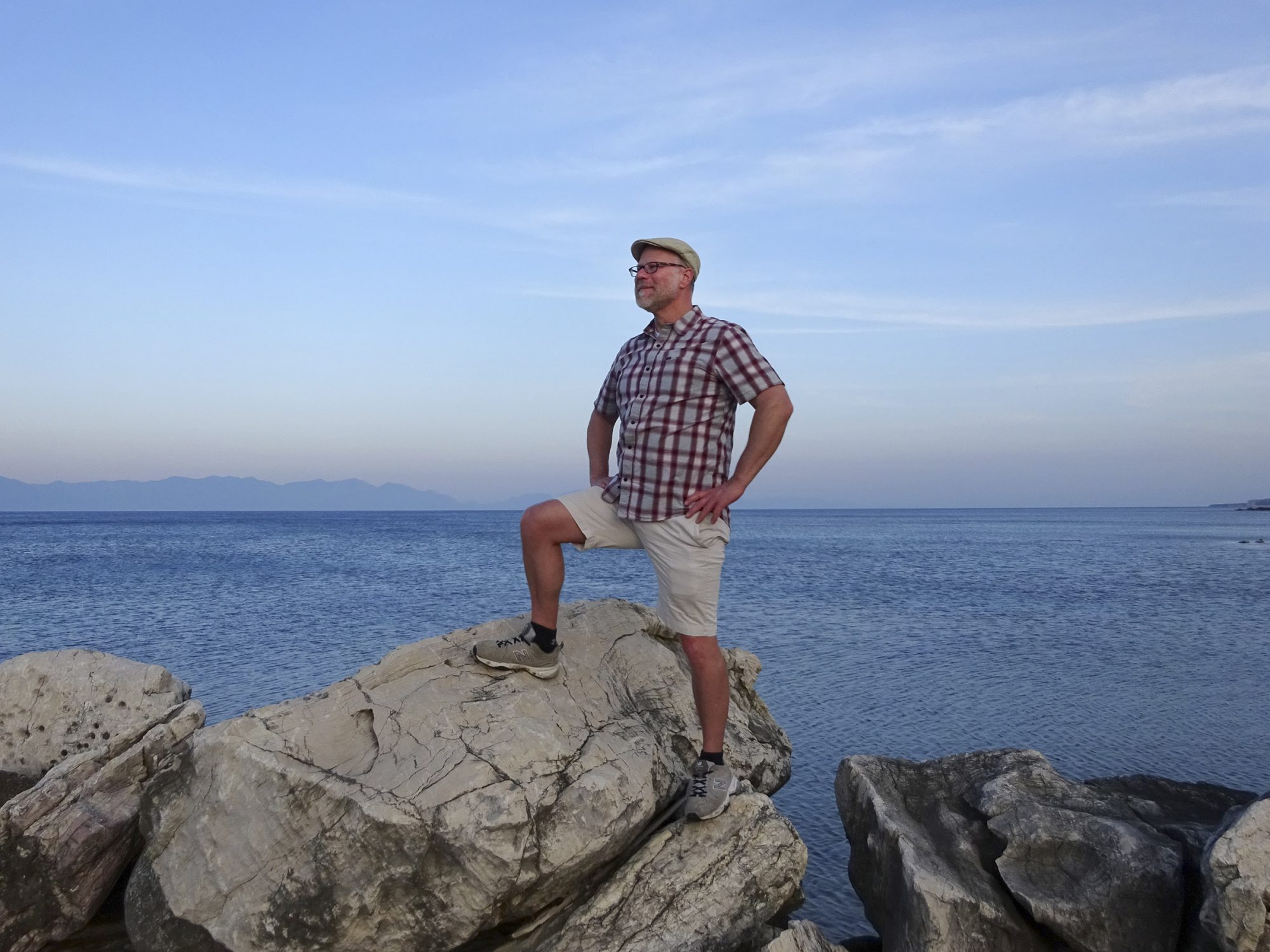Two Weeks in Frisco
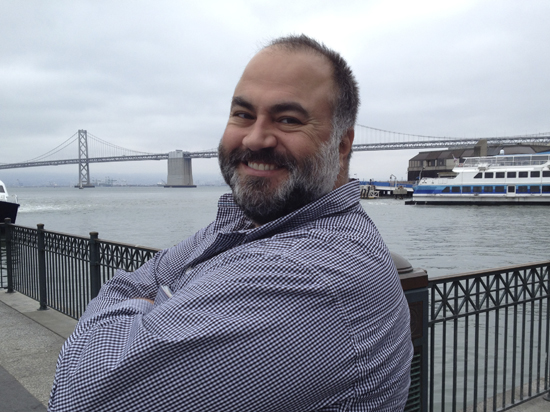
I’m not sure how the word “Frisco” became associated with a less-sophisticated appellation, but I warmly embrace it, in the company of every wisecracking dame and hard-boiled fedora-wearing tough-guy from Joan Blondell to Burt Lancaster and Edward G. Robinson, as the preferred nickname of our fair town. Stavros was here. And now he’s gone. Frisco just ain’t the same.
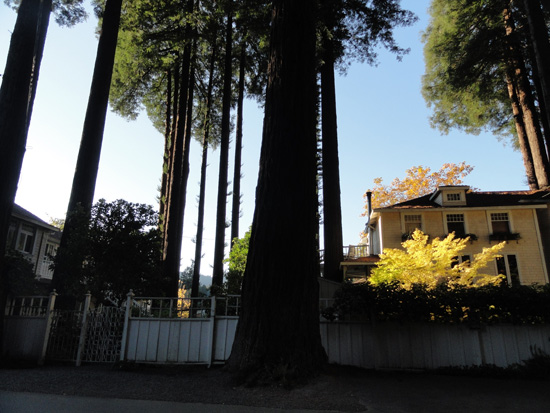
We spent a little weekend together in the Russian River, stopping in Petaluma and then driving through the Dry Creek wine country and doing some tasting. We stayed in Monte Rio, on the river under the redwoods at the Village Inn, where scenes were shot for the 1942 Bing Crosby Fred Astaire movie Holiday Inn, best remembered for the song “White Christmas.” Across the bridge, on the other side of the river is a little vintage quonset hut movie theater, The Rio, where we saw Don John. It’s so cold in the theater they give you wool blankets to snuggle up under. There were only 4 or so of us in the audience. This theater is a little gem, with murals painted by local artists, and the ceiling draped in the remnants of Christo’s “Running Fence.”
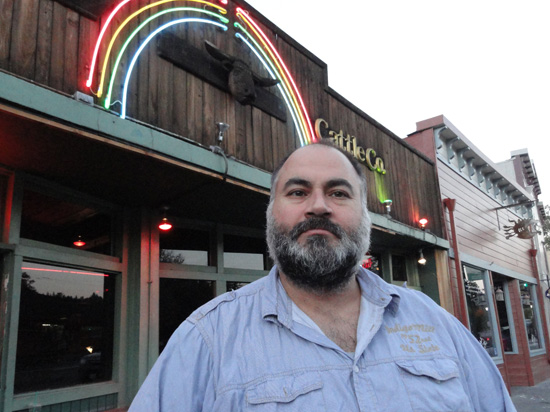
We saw the David Hockney show at the de Young. While a young student at the San Francisco Art Institute, working my way through school by cashiering at Marcello’s Pizza on Castro, one of the cooks at Marcello’s, David Dambacher, an older little man with a sort of nasally voice, took a liking to me, constantly bringing up “Daaaaa-vid.” Daaaaa-vid this and Daaaaa-vid that… David Hockney. They were friends in LA. I had never heard of David Hockney, which exasperated his attempts to impress me. I just thought, if this guy were a good buddy of this “famous” artist, what was he doing working as a pizza cook for $6.25/hour? One day he showed up while I was working and laid out a little picnic on one of the tables, with baguette, wine and cheese, and a monograph of works by David Hockney. A few weeks later at school, I noticed that my photos were missing from the darkroom drying racks. I didn’t think anything of it until I received a ransom note from David, demanding my body in exchange for my art. He continued aggressively pursuing me until one day I received a barf bag on my doorstep, covered in scribblings announcing that he was moving out of town and that I would never hear from him again, brutally assaulting my ignorance and failure to grasp the intensity and beauty of our potential coupling.

So, David Hockney. The show was great. Although he blew up these little iPad drawings into museum-ready numbered editioned prints, which completely turned me off. Rather than fully embracing a new technology, he merely made the same old stuff look like it was drawn by a robot. Otherwise, the color and scale and vibrance of the rest of the work was just the thing to enjoy as a contrast to all the conceptual and abstract swaggering going on about town. One room in particular contained one of the most mesmerizing video installations I’ve seen in a while. On each of the 4 walls of the room he mounted a grid of flat-panel TV screens, each grid showing the same scene, moving slowly down a country road, but at different times of the year, each of the 4 scenes synched at the same point on the road. Such a simple gesture, walking down a country road, but executed with extraordinarily complex visual and digital engineering. I am so sorry I didn’t know who he was when I had the chance to get some real dirt on this guy 30 years ago.
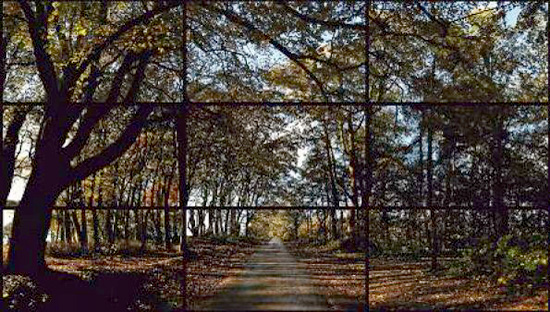
My friend Emily took us to hear Cameo in concert at Yoshi’s on Halloween. I dressed up as a swinging disco dude, Michael Caine’s little brother circa 1977. My feet were so sore from my platform shoes that I didn’t dance. I don’t know how John Travolta did it. And my head was so itchy under my wig, I just wanted to go home and wash it. But I didn’t, afterwards we wandered around Castro Street and mingled with the other revelers, constantly scratching at my wig until finally limping up the hill to my house.
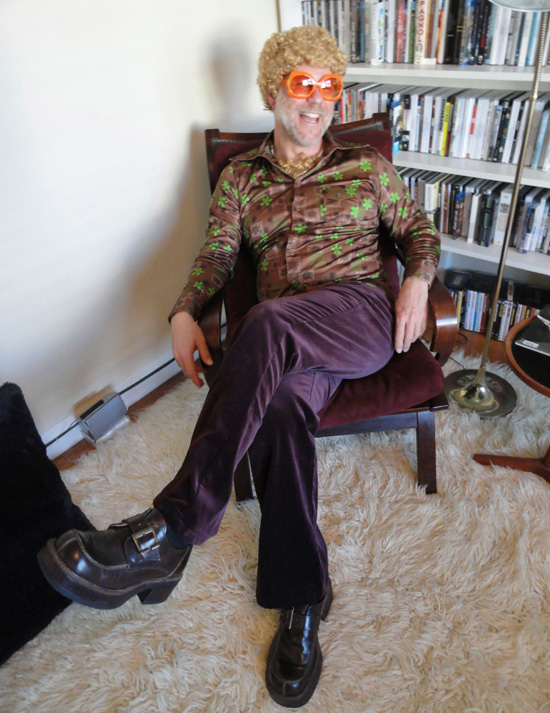
I introduced Stavros to chicken mole and dim sum on this trip. That’s like watching Vertigo for the first time. Twice. Which he hasn’t seen, actually, but I’m saving that for the next trip. We drank martinis with Dean Smith and Mike Kitchell, and I think all of us passed out during My Dog Tulip, which seemed an appropriate thing to watch and do after the Hockney show. We shopped at Macy’s. We had Little Star Pizza with my family and ended up with 2 whole leftover pizzas, the last 2 slices of which I’m currently nibbling on for lunch today. We saw Gravity in 3-D with Daniel. We went to my sister’s open studio and marveled at her ability to draw so fluidly with wire and marbles. We nibbled on free food at the Ferry Building and Trader Joe’s. I made a traditional bolognese meat sauce with texturized vegetable protein. Stavros made his famous eggs for breakfast and many recipes from his One-Spoon Project. We walked d’Auggie around the Castro together. We inadvertently staged an impromptu mini Danish film festival. We hiked with Big Chrissy and Small d’Auggie at Fort Funsten. We brunched with Dean and Chris at Kate’s Kitchen. We ate expensive pastries and drank coffee with Nemr and his current ex-husband at Craftsmen & Wolves and hung out with the hipsters on Valencia.
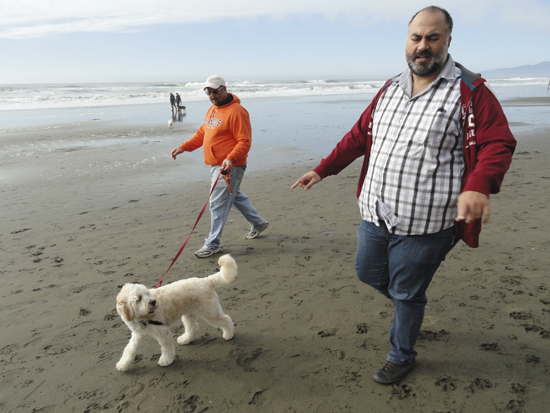
And now we talk every day via FaceTime and Skype, the vast distances between us seeming not so vast anymore.

Mefistofele
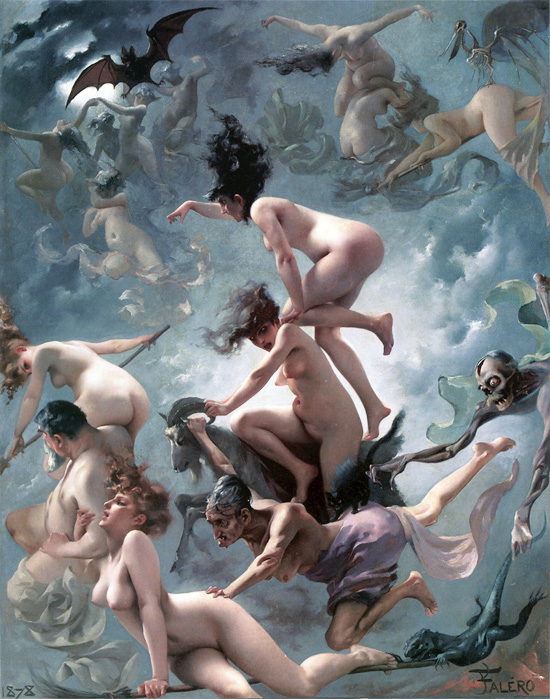
My opera-enthusiast friends S+E invited me to the opera the other night, to see Arrigo Boito’s Mefistofele. It was my first time to sit in a box, and thus my first time to experience real air flow, perfect sight lines, actual leg room, and a comfy seat to boot. Not to mention completely charming and intelligent company. And my first time to stay completely awake during a 3-1/2 hour opera.
This was Boito’s only completed opera, yet he was an accomplished man of letters who, among other literary accomplishments, wrote libretti for several other composers of his day, including Verdi’s late masterworks Otello and Falstaff. Based on the Faust legend, the opera was a complete thrill, with opulent over-the-top sets that evoked a kind of 18th century La Fenice set in heaven, and this being San Francisco, gratuitous full-frontal (and plenty of dorsal) nudity and lots of lascivious behavior. The libretto was lusciously illustrated by the music, with trilly approximations of the emotions and subject matter, plus a few truly gorgeous arias and an ending that musically lifted us out of our seats toward redemption, right along with the repentant Faust.
In the patron lounge area, there was one woman who was just absolutely fabulous. She had to have been someone important, or rich, or both, for she was wearing those big bug-eyed black glasses that only the ultra-wealthy seem to wear, a fashion sensibility of a world far from my own. She could very well have been Cindy Sherman dressed up as a society matron, if she wasn’t the actual society matron that Sherman aimed to replicate. Her bronzed face was framed by a perfectly shellacked conch of a hairdo, the bodice of her embroidered dress clinging tightly to her slim figure and hanging from a stiff collar that rose behind her head like those on silver-suited spacemen in the 1950s.
Most everybody else was dressed elegantly in black, except for me in my Mossimo corduroy jeans and Zara gold velvet jacket. I was going for the look of someone–maybe a film director or famous artist–for whom fashion is irrelevant, yet I fear that all I pulled off was Country Bumpkin.
The image above is “Witches Going to Their Sabbath” (1878), by Luis Ricardo Falero.
Pre-Sandy New York
A few years ago, when Big Chris and I were here in the winter, a blizzard was predicted to hit a few days before our departure back to San Francisco. “Let’s stick it out and see how it goes.” Well, our flight was cancelled and the earliest the airline could book us out was on a flight leaving about 10 days later. People were skiing down 8th Avenue. This time we decided not to wait around and experience canoes on 8th Avenue, so we booked a flight back today, a hop, skip and a jump ahead of Hurricane Sandy, heading up the east coast to New York City. I’m back in San Francisco now, in my shorts, reading about transportation closures and flight cancellations and breathing a huge sigh of relief.
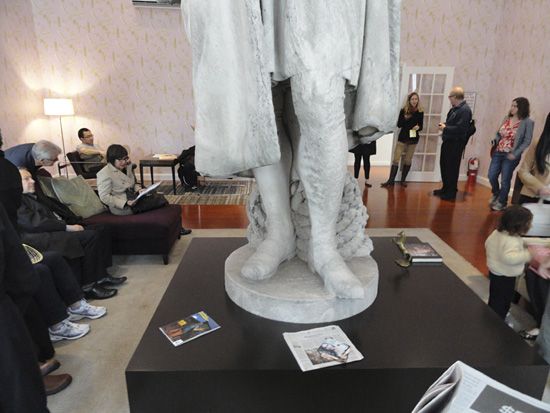
Thursday morning in New York, Chrissy and I visited Tatzu Nishi’s installation, Discovering Columbus, hovering above Columbus Circle. Around the sculpture of Columbus, in the center of the circle, about 6 flights up, Nishi has constructed a living room, with the sculpture of Columbus seemingly plunked down on a coffee table in the room’s center. The room has windows looking out on the cityscape below, approximating the perspective of the statue. There is no reference to Christopher Columbus, his voyages, Indigenous Peoples Day… just a statue in a modestly decorated living room, floating above Columbus Circle, and like what much of public art has become, a thrillingly vapid theme park ride.
And speaking of public space, it’s dominated in Rome by Bernini’s grand marble sculptures of larger-than-life saints, heavenly creatures and river gods, all ecstatic and contrapposto, swathed in lush folds of gravity-defying marble fabric. At the Met, we saw a wonderful exhibition of small-scale terra cotta mockups for many of Bernini’s major commissions. The malleability of the terra cotta shows his hand in a gestural way that is lost in the transition to marble. Thrilling! Also at the Met, we saw concurrent exhibitions of photography, Before- and After Photoshop. A hand-tinted daguerreotype portrait felt magically realistic, like a reflection. There were a bit too many examples of hand-tinting, but there were many cool pictures showing clever montage, staging, darkroom tricks, all demonstrating the pliable nature of photography and the elusiveness of representation.
At MoMA, we saw a retrospective of the Brothers Quay. Their films fetishize a kind of pre-modern turn-of-the-century-ness, and are filled with breathtakingly beautiful images of dust, broken dolls, wire, and anything that’s decaying. In addition to their films, the retrospective included sets, installations, photography, book and poster designs, and childhood memorabilia.
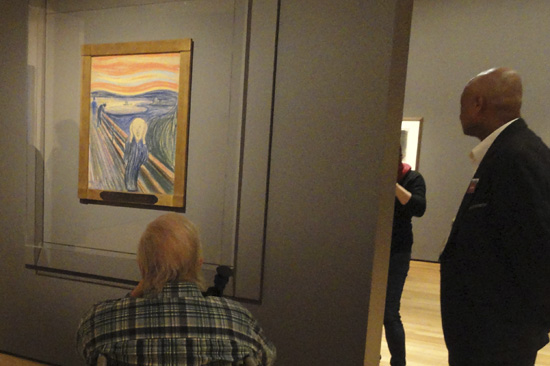
One of the screams is also on display, in a crystal sarcophagus upstairs at MoMA. This is one of four versions that Edvard Munch made, this one executed in pastel, and recently the most expensive painting sold at auction, to a private individual said to be a trustee of the Modern. $120 million. It is a pretty wonderful image, despite its intimidating price tag and bulletproof setting. It’s in a room that contextualzies the image within Munch’s Frieze of Life series, a body of work taking us from birth to death and all the calamitous tragedy in between.
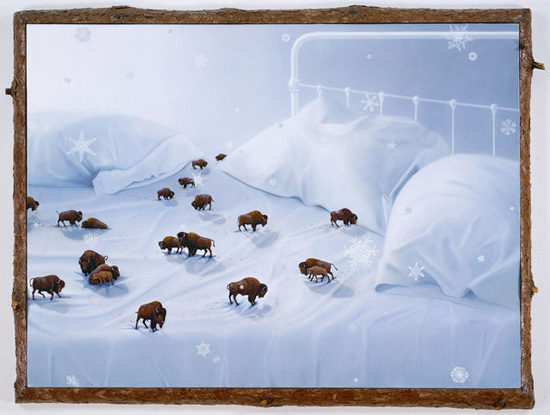
The most touching show in town was another retrospective, at NYU’s Grey Gallery, this one of Frank Moore, who died of AIDS a decade or so ago. He created grandly eloquent allegorical paintings about the degradation of our planet and our bodies from AIDS and the miracle of modern chemistry. They’re almost fairy tales, painted by a gentle soul who found beauty and depth in decay.
Meanwhile, on Broadway, we saw Henry Winkler (the Fonz!) play an aging porn star, sharing the stage with Alicia Silverstone, in The Performers, a hilarious farce that takes place on the night of the Adult Film Awards. We saw the guy who plays Matthew on Downton Abbey in The Heiress. The set was beautiful, but it felt like everybody was Acting, with a capital “A.” I had recently seen the Monty Clift/Olivia de Havilland film version, so I didn’t really feel much, other than slightly bereft. How could any actor live up to those two performances? Which brings me to Who’s Afraid of Virginia Woolf, which we saw last night. It’s really one of the great plays of the 20th century, the writing itself gives me goosebumps. But again, how do you follow up Mike Nichol’s cast from the 1966 version, one of the most perfectly cast films ever?
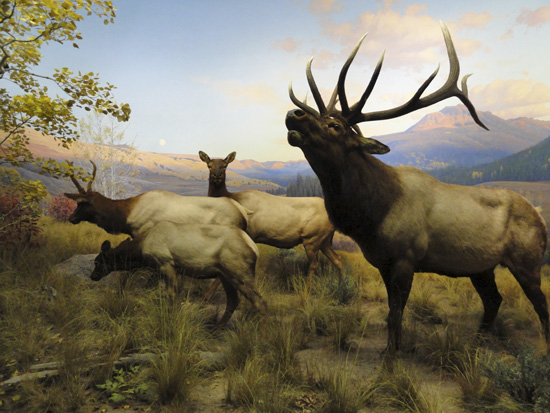
Yesterday the North American Mammal dioramas in the Museum of Natural History were opened to the public, after a lengthy restoration. They are just spectacular. Wolves, bison, spraying skunks… this is definitely a guy museum. I saw hardly any women, except in the gem section, which was all female. The other girls I saw were being pulled around by their boyfriends, or monotonously pushing perambulators behind overly-enthusiastic husbands. Boys, and mammals, everywhere.
On Broadway: Grace
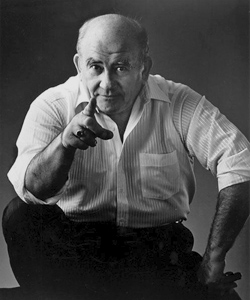 At the end of the play, Chrissy said, “Isn’t he just the cutest thing?” and I replied, “Yes, he really is looking more and more like Santa,” wiping a small tear from the corner of my eye. Perplexed, Chrissy replied, “I was talking about Paul Rudd.”
At the end of the play, Chrissy said, “Isn’t he just the cutest thing?” and I replied, “Yes, he really is looking more and more like Santa,” wiping a small tear from the corner of my eye. Perplexed, Chrissy replied, “I was talking about Paul Rudd.”
I of course, couldn’t imagine that he wasn’t talking about Ed Asner. Chrissy and I saw him onstage tonight at the Cort Theater in a production of Grace. He’s at the age when he’s an “and Ed Asner” on the Playbill, but he’ll always be at the top of my billing. I was only 30 feet or so away from him, close enough to see the still barely visible forearm hairs that fueled so much of my teen and midlife crises, finally none of those pesky screen lines between us.
The play took place in two identical apartments, across the street from each other, but, cleverly, only one stage set was used, as if one apartment were superimposed on the other. So you see all the characters in one space, even though they’re in different apartments. The play opens with the characters dead on the floor of the apartment, and then the action proceeds backwards, the actors delivering the lines in reverse that they would repeat again in proper sequence at the end of the play. So the play was not about who killed all the characters in the play, but why.
Read Ben Brantley’s review if interested in the theological and philosophical thesis behind the play, it’s midnight and I’m turning into a pumpkin.
Montserrat at the Herodion
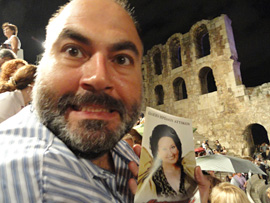 |
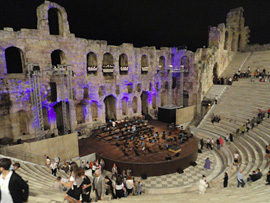 |
Hearing Montserrat Caballé sing at the Herodion in Athens was like listening to your grandmother sing in the shower. A pretty amazing shower, mind you, of marble, an open air amphitheater on the southern slope of the Acropolis, built in 161 A.D. by Herodius Atticus, and restored in the 1950’s. Montserrat is a legend, but really, your grandmother. She’s 79, and her voice, while still strong, was of a depth that allowed for few of the ornate embellishments that she’s known for, the former light playfulness of her voice now just heavy, sluggish. Bless her for still performing at her age, but when a voice fades, often it’s replaced by some kind of emotional or stylistic intensity that make up for the lost strength. I’m thinking of Billy Holiday’s spectacular Lady in Satin, released a year before her death, specifically “I’m a Fool to Want You”—I’m getting goosepimply thinking of it—her faded higher register replaced with such emotional devastation. There was no encore after Montserrat left the stage, nor a call for one, not one brava!, everybody just went home.
City Tales
Big Chrissy and I saw the musical version of Tales of the City the other night at ACT. It was so great to see the old gang again. Mrs. Madrigal endearingly flubbed her lines, calling Edgar Michael, and Brian Edgar, but it so reminded me of my mom’s own difficulty in telling her offspring apart that I loved her performance even more. It was definitely worth seeing, especially to experience so much imaginatively crammed into three hours–but you have to kind of psyche yourself up a bit: imagine Whitney Houston as Mary Ann, and the Tales of the City set to Godspell. I can’t remember a single tune, but the number about the crotch comes close.
New York: Christmas Weekend
So Big Chris and I schlepped over to Chinatown for Christmas dinner with our Jewish friends at Joe’s Shanghai. It was like being in a Woody Allen film—we waited in line for an hour, the PhDs in front of us discussing their research funding, the graduate student nervously interacting with his visiting mom and dad, someone reading Dostoyevsky, lots of yarmulkes. In addition to our main course, we accidentally ordered two plates of soup dumplings. Of course, we ate them all, having watched a video on YouTube earlier about how to not eat them like a caucasian, and perhaps overeager to display our advanced dumpling handling techniques:
And then the snow came. Like lots of it. So we went to the Whitney to snuggle up with the Paul Thek, Charles LeDray and Edward Hopper shows. I just love Edward Hopper. He’s so breathtakingly boring, all those desolate exteriors and empty storefronts, but so of his time, and such a great handler of paint and shadow.
Also engaged with the mundane, Charles LeDray’s show featured dynamite manipulations of scale: miniature hand-thrown and painted ceramic pots the size of thimbles, thousands of them; tiny outfits hanging from tiny hangers… what a nimble and inventive craftsman.
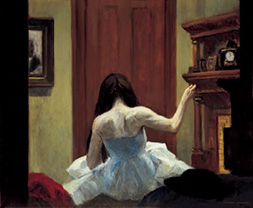 |
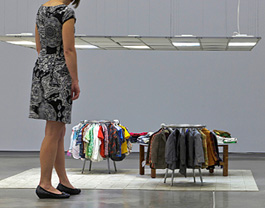 |
And then on to Paul Thek, who made sculptural installations before all those crappy scatter art things that we keep having to wade through in all the galleries these days. In the context of the museum, detached from the environments and performances that the artist staged, the works felt like, well, like the hunks of meat that he created out of wax—parts of something once very much alive.
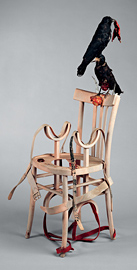 |
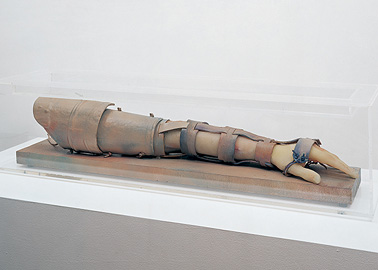 |
Back up to Times Square that evening, we got tickets to see Jeffrey Wright in A Free Man of Color, John Guare’s boisterous new play about a pre-historic (1802) sexually charged, racially progressive New Orleans, just prior to the Louisiana Purchase. I was just happy to see Jeffrey Wright and to thaw out my feet.
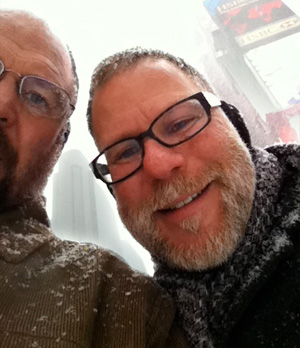
New York: Monday to Wednesday
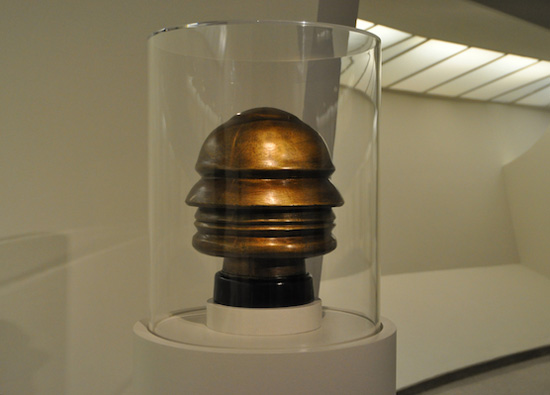
I’m still in New York, still freezing. Big Chrissy and I saw an interesting show at the Guggenheim, Chaos and Classicism, focusing on european art between the World Wars. Pictured above is Renato Bertelli’s Profilo Continuo del Duce (1933), a dazzling futurist portrait of Mussolini included in the show.
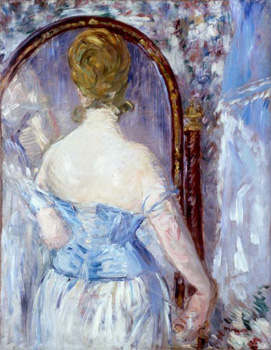 |
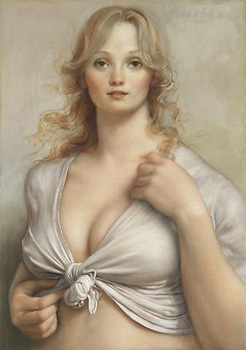 |
Manet’s Devant la Glace, (1876) was also on display at the Guggenheim, a vigorously painted portrait of a woman at a mirror, her back to us, a private scene of observation. The tension between surface and subject is heightened by our own position of surveillance. First Picasso’s women, and then John Currin’s at Gagosian continued our engagement with the female form, the latter like viewing a pornographic Saturday Evening Post.
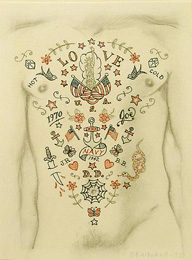 |
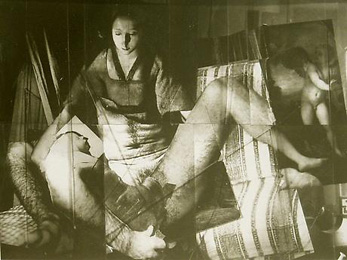 |
Moving on to the male form, we stopped by the Tibor de Nagy Gallery for the Jess, Joe Brainard, and John O’Reilly show. While each artist utilized collage to create works of tender sensuality, John O’Reilly’s layered and sliced imagery haunted me the most, sublime juxtapositions of sexual, erotic and aesthetic experience.
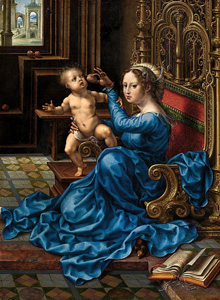 |
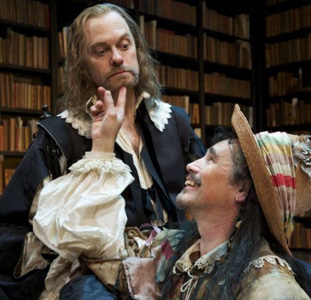 |
At the Music Box on Tuesday night, we saw La Bête, a satire set in the 17th century, with Joanna Lumley in her Broadway debut—and boy does she make an entrance, in a billowy shower of gold. The play is presented entirely in rhymed verse, whimsically and cleverly illustrating the triumph of mediocrity over quality.
The next day we stepped back another century for Jan Gossart at the Met, and forward again for a fabulous restored Velasquez portrait of Philip IV.
New York
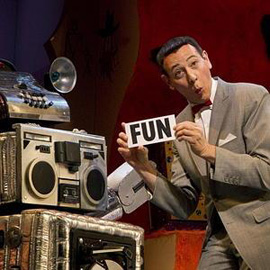 |
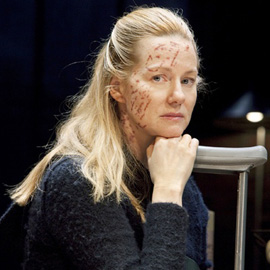 |
I’m in New York, though the 28th. New York, New York. With Big Chrissy. It is cold. Like, how do people survive outside a Mediterranean climate? It’s like another planet here. So far we’ve seen Laura Linney and Christina Ricci (in her broadway debut!) in Time Stands Still, and Paul Reubens’ The Pee Wee Herman Show with most of the original cast. Pee Wee started the show by asking us all to stand and face the flag and recite the Pledge of Allegiance. The production is a distillation of his 80s Saturday morning TV show, with a few added references to his penal experience. What a fantastic show. I remember when I was a kid, trying so hard to get into Sesame Street, desperately analyzing Zoom! for the slightest hint of something that spoke to me and my experience… but it wasn’t until my first years of college and Pee Wee’s Playhouse that I finally found the show that I longed for as a child. There’s no disjunction between childhood and adulthood, adolescence is conveniently set aside. Miss Yvonne is still the most beautiful woman in Puppetland, and Jambi finally got hands to do what he’d been wanting to do all those years.
Tomorrow it’s the Guggenheim, then Jess, Joe Brainard, and John O’Reilly at Tibor de Nagy. Stay tuned…
